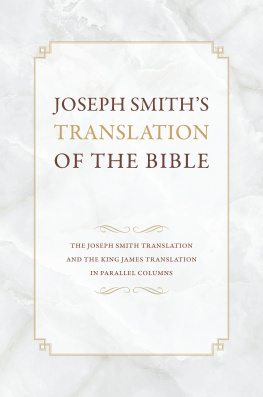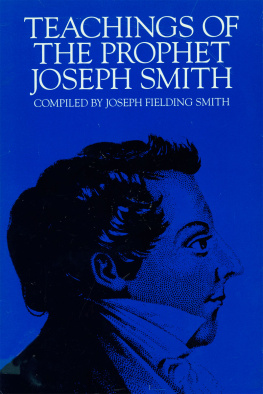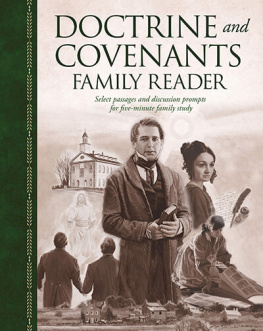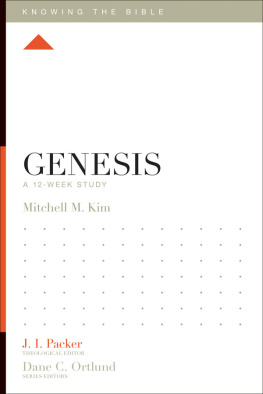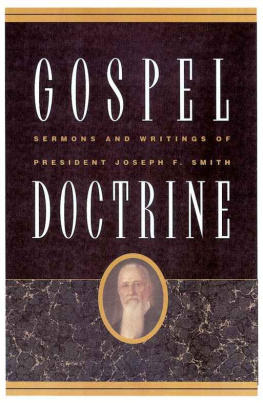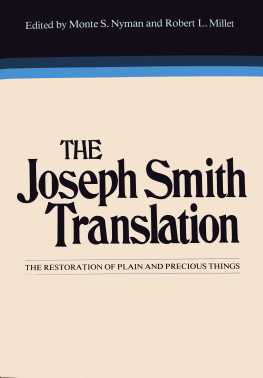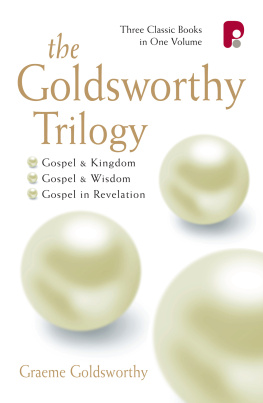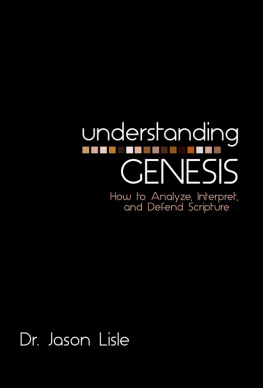The Restored Gospel and the Book of Genesis
Kent P. Jackson
2001 Kent P. Jackson.
All rights reserved. No part of this book may be reproduced in any form or by any means without permission in writing from the publisher, Deseret Book Company (permissions@deseretbook.com), P.O. Box 30178, Salt Lake City Utah 84130. This work is not an official publication of The Church of Jesus Christ of Latter-day Saints. The views expressed herein are the responsibility of the author and do not necessarily represent the position of the Church or of Deseret Book. Deseret Book is a registered trademark of Deseret Book Company.
Library of Congress Cataloging-in-Publication Data
Jackson, Kent P.
The restored gospel and the book of Genesis / Kent P. Jackson.
p. cm.
Includes bibliographical references and index.
ISBN 157008727-X
1. Bible. O.T. Genesis EnglishVersionsSmith. 2. Bible. O.T. GenesisCommentaries. I. Title.
BX8630 .J33 2001
222.1106088283dc21 2001004761
Printed in the United States of America18961-6868
R. R. Donnelley and Sons, Crawfordsville, IN
10 9 8 7 6 5 4 3 2 1
Preface
This book is an exploration of Genesis in the bright light of the latter-day restoration of the gospel. It does not cover all the people, events, and teachings of Genesis, only those for which modern revelation through the Prophet Joseph Smith has provided new context, clarification, or understanding.
We do not have all the answers to the questions that naturally arise from our reading of scripture, and this is probably more true with regard to Genesis than any other book. But it is also true that modern revelation provides the keys for our understanding and teaches us clearly those things that matter most. My desire in this volume has been to show what the questions are and what the sources are for dealing with those questions. The answers I have proposed are my own interpretations. It has been my intent that they be consistent with what the Lord has revealed, but I encourage readers to go beyond my conclusions to the true sources themselvesthe standard works of the Church and the inspired teachings of the Lords prophets.
I would like to thank my generous colleagues and student research assistants at Brigham Young University who read chapters of this book and provided recommendations for its improvement. And I am grateful to my wife, Nancy, whose careful readings yielded much-appreciated suggestions.
Introduction
Beginning with the First Vision , the latter-day restoration of the gospel has set in motion a significant interaction between new revelation and the Bible. In some cases that interaction has been a reaffirmation of the Bibles integrity and the truth of its history and teachings. One of the Restorations purposes has been to prov[e] to the world that the holy scriptures are true (D&C 20:11; cf. 1 Ne. 13:39). Modern revelation has served to sustain, defend, and establish the truth of the Bible by providing additional witnesses to its history and teachings (1 Ne. 13:40).
In other cases, the interaction of the Restoration with the Bible has been to show that there is much truth that has been lost since the time of its original writers. The scriptures of the Restoration, as an angel told the Book of Mormon prophet Nephi, would make known the plain and precious things which have been taken away. Above all, modern revelation would make known to all kindreds, tongues, and people, that the Lamb of God is the Son of the Eternal Father, and the Savior of the world; and that all men must come unto him, or they cannot be saved (1 Ne. 13:40).
The contributions of modern revelation to our understanding of Genesis come from several sources. It is in Genesis that the Joseph Smith Translations largest and most significant insertions are found, with page after page of new material unknown from any other source. To those revelations are added important contributions from the Book of Mormon, the Doctrine and Covenants, the book of Abraham, and Joseph Smiths sermons and writings. Together they reveal fundamental doctrines that set apart our religion from the rest of Christianitydoctrines that are at the very heart of the Latter-day Saint faith.
This volume attempts to bring together the book of Genesis, passed down through the centuries from antiquity, with sources revealed in the latter days that flood it with truth and light. We see first how modern revelation teaches us of the identity of Jehovahthe God of the Old Testament. We learn how his acts of creation, revelation, and atonement have been manifested from before the world to our own time. We are reminded that it is through latter-day revelation that we come to know him better than we could if we had only the Bible as our guide (chapter 1). We learn how the Latter-day Saint view of the Bible has caused some of our fellow Christians to question our belief in it. We believe, indeed, that it has not been transmitted to us in its ancient purity, and we believe in other scripture in addition to the Bible. Yet we see how modern revelation does not distract us from our belief in the Bible but serves to confirm to us its value and its truth (chapter 2). We learn what the Joseph Smith Translation of the Bible is, how we obtained it, what it does, and how it serves as a witness both for Christ and his work and for the prophetic ministry of Joseph Smith (chapter 3). We learn also what the Old Testament isa great collection of books that include the writings of prophets, historians, and poets who bore testimony of Jehovah anciently and continue through their words to reach out to us today (chapter 4).
Modern revelation does not give us all the answers to difficult Bible questions, but it does give us tools that we need as we approach those questions. We discuss the authorship of Genesis and see what the restored gospel teaches on that matter. Moses is our best choice as the author, but many intriguing questions remain (chapter 5). Similarly, the first lesson we learn about the Creation is that there are many things about it we do not know and probably will not know until the Millennium. We attempt to separate things of which we can be certain from those for which we need further thought and revelation. We see how scripture and the principles of science are not opponents but complementary revelations of Gods creative work (chapter 6). We learn how modern revelation reaffirms the reality of Adam and Eve. Even though we do not know all the answers about how they were created, we do know of their uniqueness among Gods creations and of their role in his divine plan (chapter 7). The restored gospel teaches us of the reality of the Fall. We learn what the circumstances were in the Garden of Eden and how the Fall brought consequences that we still experience today. We see that the Fall was part of Gods grand design for his children and how the atonement of Jesus Christ overcomes its effects and enables us to return to our Heavenly Father (chapter 8).
One of the most dramatic revelations of new text in the Joseph Smith Translation of the Bible focuses on the years between the fall of Adam and the translation of the City of Enoch. We see the expanding influence of Satan in the world as humanity moved on the course that led eventually to the Flood and the destruction of almost all humankind. Yet we see that in those same days, the kingdom of God was growing, culminating in the removal of Enoch and his sanctified city from the earth. In these revelations we learn the principles of Zion that apply in all generations, including our own (chapter 9).


